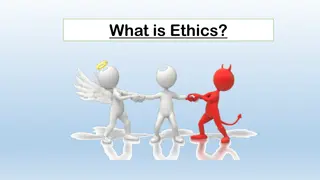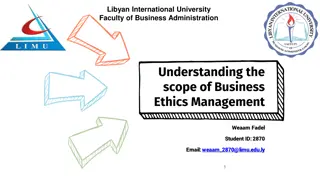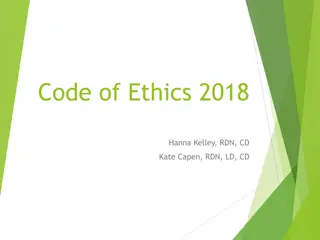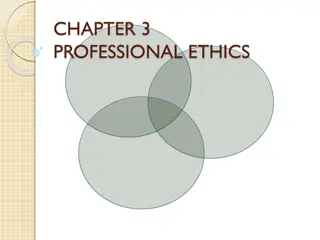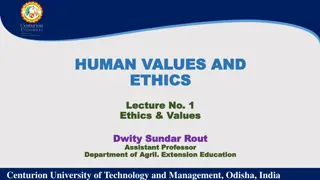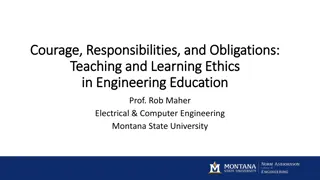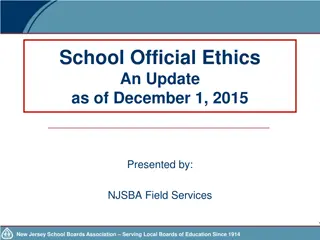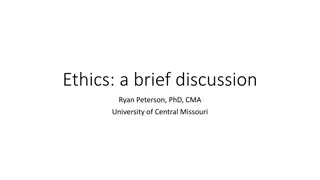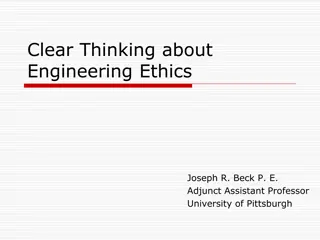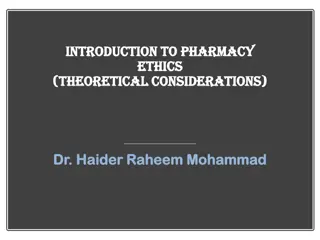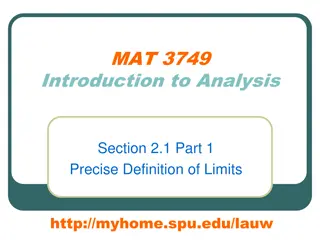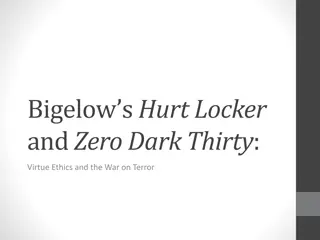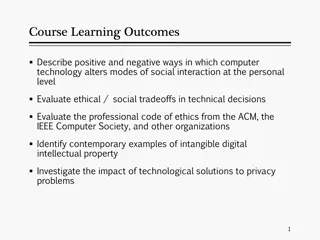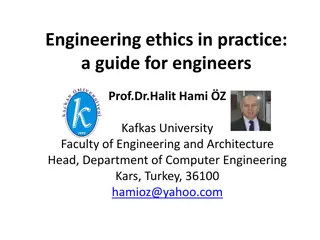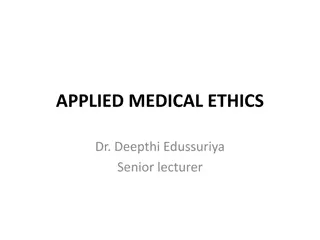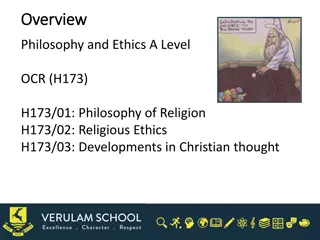Ethics in Engineering Practice: Staying Within Your Limits
Environmental Impact Assessment (EIA) specialist engineer approached for a project exceeding his competency level. While competent in most aspects, the engineer lacks expertise in traffic impact assessment. He must decide whether to proceed personally or recommend hiring a specialist, balancing ethical considerations and professional responsibilities.
- Engineering Ethics
- Environmental Impact Assessment
- Professional Competence
- Ethical Dilemma
- Engineering Practice
Download Presentation

Please find below an Image/Link to download the presentation.
The content on the website is provided AS IS for your information and personal use only. It may not be sold, licensed, or shared on other websites without obtaining consent from the author. Download presentation by click this link. If you encounter any issues during the download, it is possible that the publisher has removed the file from their server.
E N D
Presentation Transcript
Engineering ethics in practice: a guide for engineers Prof.Dr.Halit Hami Z Kafkas University Faculty of Engineering and Architecture Head, Department of Computer Engineering Kars, Turkey, 36100 hamioz@yahoo.com
I used the Engineering ethics in practice: a guide for engineers book written by The Royal Academy of Engineering for teaching as well as making the ppt presentations about the Engineering Ethics course Prof.Dr.Halit Hami Z Prof.Dr.Halit Hami OZ - Engineering Ethics Course 2
2.2 Staying within your limits Professional engineers should perform services only in areas of current competence Scenario An engineer who is trading as a consultant specialises in performing Environmental Impact Assessments (EIAs) for industrial developments. The engineer is approached by Pellar Paper Ltd, a company that is planning to build a paper and board production plant, and is offered the job of performing an EIA for the development, which he accepts. As the facility will produce over 200 tonnes of paper and board per day, legislation necessitates that an EIA is included as part of the submission to the local planning authority. Pellar Paper has already received a scoping opinion from the local planning authority, indicating the areas in which they have concerns. The engineer s job is to describe the likely effects of the plant on various aspects of the environment and local community, and the mitigation efforts that will be made. Prof.Dr.Halit Hami OZ - Engineering Ethics Course 3
2.2 Staying within your limits There are many kinds of environmental impact that have to be considered for this project. They include (but are not limited to) treatment and disposal of waste water, the visual impact of the development, noise pollution from the machinery and effect on air quality of emissions from the on-site incinerator. As an EIA specialist the engineer is expected to have a sufficiently broad understanding of engineering to be able to make informed judgements about these effects. However, one of the areas of concern highlighted by the local planning authority and the highways authority is the effect of the increase in the road traffic caused by the development. Prof.Dr.Halit Hami OZ - Engineering Ethics Course 4
2.2 Staying within your limits Unlike the other key elements of this EIA, the engineer does not feel competent to undertake the traffic impact assessment required in this case. He does not feel able to gauge the precise increase in traffic, nor its effect on the nearby village and the local road network, which includes many narrow country lanes. In the past, he has handled traffic assessments in one of two ways: if they have been simple or straightforward he has conducted them himself. If they have been more complex he has recommended the employment of a specialist in this area to provide the necessary input. Prof.Dr.Halit Hami OZ - Engineering Ethics Course 5
2.2 Staying within your limits The engineer discusses the issue with Pellar Paper. He states that in his judgment the traffic will not cause significant problems, and such problems as there are could be mitigated in various ways. Nonetheless, given the importance of this issue and the fact that it has already been raised by the local planning authority, he is not sufficiently confident in his judgment and recommends that a traffic impact expert is employed to undertake this aspect of the EIA. Pellar Paper is not keen on this idea, highlighting concerns about the extra time and expense of hiring a consultant. More than this, however, the engineer is left with the impression that Pellar Paper are worried that detailed scrutiny might uncover the kind of negative impact that will worry the local planning authority or the highways authority. Pellar Paper urges the engineer to make the traffic impact assessment himself, and to state that in his judgement that there will be no negative effects due to the increase in traffic. Prof.Dr.Halit Hami OZ - Engineering Ethics Course 6
Dilemma Imagine you are the engineer in question. Whilst completing an Environmental Impact Assessment (EIA) for a paper manufacturing company, you have been urged to include your judgement that the increase in traffic caused by the development will not have a negative effect. However, you do not feel sufficiently competent in this area to be confident in your judgement and think that the company should engage a specialist consultant, which they are reluctant to do. Prof.Dr.Halit Hami OZ - Engineering Ethics Course 7
What should you do? You could explain that since you do not believe that you are competent to complete the traffic assessment in this case you will be unable to continue to work for Pollard Paper unless they engage an independent expert traffic impact consultant. You could agree to complete the EIA, but restrict yourself to matters other than traffic, so leaving it incomplete. You could accept the view of Pollard Paper and include your own view, of which they approve, in the EIA, as they are your clients and you do feel capable of making a traffic assessment with some level of accuracy. Prof.Dr.Halit Hami OZ - Engineering Ethics Course 8
Discussion In this case study, you are being pressurised to make a judgement that you feel is outside your areas of competence. The client is less interested in you making a thorough and accurate assessment than in you making an assessment that will favour their plans. This places you under an obligation to consider the best way of producing a satisfactory EIA, whilst bearing in mind the interests of the client. Prof.Dr.Halit Hami OZ - Engineering Ethics Course 9
Discussion One of the key elements in this case study is not only the need to be aware of your limitations, but the need to be confident in your communication of those limitations. Circumstances can make it tempting to claim competence which you do not have, or to acquiesce to other people s expectations of certain knowledge and skills. It may make their life easier if you perform a certain task, but that does not make it the right thing in the long run for you to do. Prof.Dr.Halit Hami OZ - Engineering Ethics Course 10
Discussion This can be particularly relevant at the beginning of a project, where it may be easy to overlook unrealistic expectations of your competence. Or you may notice, but it might not seem like a significant issue. Projects develop their own momentum however, and it in most situations it will be easier to be clear at the outset about your range of expertise, even if that may disappoint clients. Prof.Dr.Halit Hami OZ - Engineering Ethics Course 11
Discussion Given the options presented, 1 and 2 may well amount to the same thing Pellar Paper are unlikely to want to receive a report that omits a key element that has been requested by the planning and highways authorities. In this case you may be faced with a simple choice between doing the whole report and getting paid and not doing any work at all. It is in tough practical situations such as this that doing the right thing is the hardest. However, the earlier comments about setting expectations early are particularly relevant here if you had set out clearly the services that you were able to supply at the beginning, you may not have found yourself in this difficult position in the first place Prof.Dr.Halit Hami OZ - Engineering Ethics Course 12
Summary In this case you have made your judgement about your competencies clear to the client, but for apparently commercial reasons they are keen for you to include your assessment (of which they approve) even if you are not confident of its thoroughness and accuracy. In this situation it is your responsibility to ensure that any work you sign off has been conducted competently. If you are not confident that this is the case with the traffic assessment then you should not put your name to it. Unfortunately this may mean that you will have to withdraw from the project, unless you can persuade your client to employ an expert in traffic impact assessment. Prof.Dr.Halit Hami OZ - Engineering Ethics Course 13
Other ethical considerations involved in this case This case study raises issues of honesty and integrity, particularly if you think the report risks deceiving readers, or has been the subject of improper influence. The potential adverse effect on society of a poorly completed EIA also brings in considerations of the respect for life, law and the public good. Finally, you will need to consider whether your actions in this situation would violate your duty to show responsible leadershipby ensuring all statements you make in your professional capacity are objective and truthful. Prof.Dr.Halit Hami OZ - Engineering Ethics Course 14
Other ethical considerations involved in this case This case study dealt with the issues that can arise when you are pressurised to offer a judgement that you feel to be outside your area of competence. But there are other ethical issues that can arise in the realm of professional competence. One is that it can sometimes be difficult to decide what is, and what is not, included in your area of competence. One factor that can make this difficult is that what counts as knowledge sufficient to back up a professional judgement can vary greatly depending on the situation Prof.Dr.Halit Hami OZ - Engineering Ethics Course 15
Other ethical considerations involved in this case Depending on various complex factors, an engineer may have to have decades of specialised experience in order to provide an assessment, or may only require a passing familiarity. For instance, compare the situation of the chief engineer on the launch of a space shuttle with the same engineer discussing rocket propulsion with A-level students. The levels of expertise required in order to offer a competent judgement will differ radically in these two situations. Awareness of the nature of the situation, and the expectations of the people affected by the decision, is a key part of being aware of your limitations. Prof.Dr.Halit Hami OZ - Engineering Ethics Course 16
Other ethical considerations involved in this case Another issue is what precisely counts as a standard area of engineering competence. Engineering is very multi-disciplinary, and a typical engineer may be expected to make decisions about a vast array of different issues, ranging from molecular and atomic factors to ways in which people and communities behave. There are various ways in which these areas of competence are codified, including the standard range of modules in undergraduate degrees. But there are still areas where individual reflection is required. Should an engineer be expected to make judgements about issues that are more social in nature? Prof.Dr.Halit Hami OZ - Engineering Ethics Course 17
Other ethical considerations involved in this case For instance, should an engineer developing a home surveillance system for the elderly be expected to make a judgement about the impact of the system on personal privacy? Is that rightly considered an engineering issue? There may well be engineering decisions that are closely and inextricably linked with social, political and ethical issues. Furthermore, engineering is a dynamic discipline, with many engineers working with emerging technologies with unknown impacts, or on one-off major projects. In such cases engineers have to manage the risks of using novel methods rather than relying on tried and tested knowledge. Prof.Dr.Halit Hami OZ - Engineering Ethics Course 18
2.3 Keeping up to date Professional engineers should keep their knowledge and skills up to date and assist the development of engineering knowledge and skills in others. Scenario lexander Boyd is the Managing Director of Icarus Aeronautics, a medium size aeronautical engineering company. For the last year or so work in the sector has been hard to come by, but Icarus has been fortunate to have an excellent relationship with a particular airline. This airline has engaged Icarus in a large, ongoing project to redesign multiple elements of the interior of its planes, for example, seats, overhead lockers, hostess trolleys. With very little other work coming in, it is only this project that is sustaining Icarus, and even then the financial situation is perilous. Prof.Dr.Halit Hami OZ - Engineering Ethics Course 19
2.3 Keeping up to date In order to manage this situation, Alexander has taken a number of measures. Despite having teams with varying specialities, virtually all the engineers employed by Icarus are now working on the airline project. In addition, all non-essential expenditure has been cut back, and this includes training that is not required by existing projects. Prof.Dr.Halit Hami OZ - Engineering Ethics Course 20
2.3 Keeping up to date One of the teams within Icarus specialises in developing and designing safety critical composite airframe structures, although they too have been working on designing cabin fixtures for the best part of a year. The head of this team, Sarah McKay, requests a meeting with Alexander and voices a number of concerns. She says that her team are not very happy with their current work although, in general, they understand the need to arrange things this way. Part of their concern, however, is that their skills in composite airframe structures are becoming outdated. The best way to keep these skills up to date would be by working on a relevant project and undertaking training, but in the absence of any such projects she asks if the team can at least be allowed to continue training in this area. Prof.Dr.Halit Hami OZ - Engineering Ethics Course 21
2.3 Keeping up to date Alexander tells Sarah that he understands her concerns and that he will consider her request. He does not want to lose the capability to do this specialist work and he does not want the team to be unhappy, but at the same time he does not know how he can afford to take them off their current work and pay for additional training. In addition, he also knows that there are other teams in a similar position who could also make a request for training if he agrees in this case Prof.Dr.Halit Hami OZ - Engineering Ethics Course 22
Dilemma Imagine that you are Alexander Boyd, Managing Director of Icarus Aeronautics. You have a responsibility to assist the development of engineering knowledge in others, particularly those who work for you. However, by agreeing to the request of your team leader and sending her team on training to update their specialist skills you will have to take them off the project that is sustaining the company and spend money that will generate no immediate return. Moreover, even if you did allow the training you would certainly be unable to fund similar requests from other teams. On the other hand, if Icarus loses all it specialist skills, it will be harder to acquire new work and complete it competently. Should you allow this team to undertake the requested training? Prof.Dr.Halit Hami OZ - Engineering Ethics Course 23
What should you do? You could agree to the request in this instance, believing that you can bear the cost once, while making it clear to the team and the rest of the company that this is an exception. You could refuse the training, citing the current market conditions and the particular financial pressures on Icarus. You could agree to the request in principle, but make it clear that any training will only be approved if accompanied by a business case showing how the team intend to use the training to generate income for Icarus. Prof.Dr.Halit Hami OZ - Engineering Ethics Course 24
Discussion Assisting in the development of engineering knowledge and skills in others is a central responsibility for engineers, particularly when the people concerned are employees for whom engineering is a core skill. Indeed, as a member of a professional Institution it may be a requirement to carry on with professional development. However, in this case it is clear that approving all relevant training across the company is not a viable option Icarus Aeronautics would go out of business to the detriment of all employees. Given that this is the case, perhaps a balance can be struck by approving the training just in this instance; you could argue that you are discharging your responsibility as best you can given the constraints that exist. Prof.Dr.Halit Hami OZ - Engineering Ethics Course 25
Discussion The problem with this approach is that you need to decide how to respond when other teams in the same position complain that they have not been given the same opportunity to maintain their skills. Such preferential treatment based only on the fact that one team complained first does not seem to be fair. This being the case, it may be better, in the interests of fairness, to deny all teams training, while making clear that it will be permitted again once conditions have improved and resources are available to fund training for all. Prof.Dr.Halit Hami OZ - Engineering Ethics Course 26
Discussion Such a solution may be fairer, but it again risks failing to satisfy the requirement to ensure that engineering skills are kept up to date. This is particularly the case if Icarus Aeronautics maintains ambitions to undertake specialist work, such as designing composite airframe structures, in the future. One central reason that maintaining up to date knowledge is important is to ensure that work is always conducted to the highest possible standards. By denying your teams the opportunity to maintain their skills you may either have to reduce the range of work that you bid for, or risk undertaking work that you are not competent to perform. Prof.Dr.Halit Hami OZ - Engineering Ethics Course 27
Discussion A possible solution to this dilemma could be to consider the third option. By requiring business cases to accompany training requests you could ration training according to your budget, and could make the rationing criteria fairer than first come, first served . By making as much money available as possible given your constraints, you would also be fulfilling your duty to maintain knowledge. Prof.Dr.Halit Hami OZ - Engineering Ethics Course 28
Discussion This may indeed be the best solution available given the significant financial pressure that the business is under, and the disastrous consequences for all involved should it fold. However, it may be that you should still exercise caution some training may not obviously lead to incremental revenues for the business, but instead may be necessary to ensure the quality and safety of work currently being undertaken. What attitude would you take to training of this kind? Perhaps by offering all employees time for professional development as long as it did not incur any costs such considerations could be taken into account Prof.Dr.Halit Hami OZ - Engineering Ethics Course 29
Discussion Finally, if the financial situation became so difficult that it was impossible to fund any training or allow staff to take time off for professional development, is there a point at which the survival of the business becomes less important than ensuring that its employees have up to date skills (for example, if skill levels were no longer sufficiently up to date to be able to ensure the safety of projects undertaken)? How would you decide when this point was reached? Prof.Dr.Halit Hami OZ - Engineering Ethics Course 30
Summary It is a reality of business that financial pressures constrain the opportunities for engineers to engage in training to enhance and update their skills. In this case the constraints are very tight and so training will have to be tightly rationed. By allocating available training based on business requirements and by exploring other ways to pursue professional development you might fulfil your responsibilities to keeping skills up to date to the best of your ability, while being as fair as possible. This should also ensure that all employees are competent to undertake the tasks required of them. Nonetheless, how would you respond if faced with a number of equally valid requests that cannot all be met? Or if it proved impossible to finance all training necessary to maintain basic skills to an acceptable level? What trade-offs is it acceptable to make in order to keep your business running? Prof.Dr.Halit Hami OZ - Engineering Ethics Course 31
Other ethical considerations involved in this case Keeping engineering skills up to date will also affect an engineer s ability to maintain accuracy and rigour in other respects, such as their ability to act with care and competence, and to evaluate risks. Equally, honesty andintegritywould not be served by leading others to think that you wereexpert in a particular area when you did not possess the latest knowledge. This in turn could cause damage to your reputation and that of the profession, and would be at odds with the requirement to respect life, lawand the public good. This case study also raised questions of fairness relatingto the allocation of training within a company. Prof.Dr.Halit Hami OZ - Engineering Ethics Course 32
2.4 Ensuring others are not misled Professional engineers should not knowingly mislead or allow others to be misled about engineering matters Scenario Bradlet Structural, a firm that provides consultancy services regarding structural integrity and subsidence evaluation for heritage sites, has been hired by STZ, a contracting company that has been building a complex of luxury flats in the centre of a market town. Work has been halted as concerns have been raised about the effect of the building work on some nearby historic buildings, including a Medieval church and a street of Grade 1 listed buildings Prof.Dr.Halit Hami OZ - Engineering Ethics Course 33
2.4 Ensuring others are not misled The development was controversial from the outset, being situated so centrally, but the Local Authority was persuaded that the design would be in keeping with the surrounding buildings, and would regenerate the centre of the town. Prof.Dr.Halit Hami OZ - Engineering Ethics Course 34
2.4 Ensuring others are not misled In an effort to satisfy the planning officers as well as the local media and the community of the town, STZ engages Bradlet Structural to undertake an evaluation to demonstrate that their building work is not having a negative effect on the structural integrity of the church. Specifically, Bradlet Structural has been charged with investigating the possibility that construction of the foundations of the development is causing ground settlement and subsidence underneath the church building. STZ is hoping to use Bradlet s report to allay local worries, and to allow building work to continue. A team is sent to perform the evaluation. Prof.Dr.Halit Hami OZ - Engineering Ethics Course 35
2.4 Ensuring others are not misled In the course of the team s investigation, it discovers evidence that points to significant recent subsidence in the vicinity of the church. The foundation work on the flat development is the clear cause of this subsidence, which is likely to exacerbate the increasing natural problems with the structural integrity of the medieval church. Prof.Dr.Halit Hami OZ - Engineering Ethics Course 36
2.4 Ensuring others are not misled Before compiling a report, the team leader verbally advises STZ of the team s findings, and their conclusion that there is a high risk of further development causing structural damage to the church building if the working methods are not changed. On receipt of this information, STZ informs Bradlet Structural that the consultancy contract will be terminated, with full outstanding fees paid. Bradlet Structural is no longer required to compile a written report. Prof.Dr.Halit Hami OZ - Engineering Ethics Course 37
2.4 Ensuring others are not misled Some weeks later, when the controversial issue of the development work is being covered in an influential local paper, a member of the Bradlet Structural team notices that representatives from STZ have claimed that the development work is having no effect on local subsidence, and that the church is under no threat from the building work. The representative further claims that STZ have evidence (by implication from Bradlet Structural) to support that view. Prof.Dr.Halit Hami OZ - Engineering Ethics Course 38
Dilemma Imagine you are the team leader from Bradlet Structural. It is your responsibility as a consultant to give advice on whether you think a building project is a threat to the structural integrity of a local church. By ignoring your advice and claiming that the church is under no threat, the company who engaged your services, STZ, has given information to the public that you feel to be false, about a topic that has the potential to cause harm to people and property. Furthermore, you have substantial evidence that this is the case, gathered by your team in a professional capacity. How should your team act? Prof.Dr.Halit Hami OZ - Engineering Ethics Course 39
What should you do? You could decide to say nothing, given that the information in your possession was gathered whilst your company was employed by STZ, and there is an obligation to be loyal to those who pay for your services. You could inform STZ that you do not agree with their public statements on the matter of the subsidence around the church, and that they should reconsider their position in the light of the information that your team gathered whilst in their employment Prof.Dr.Halit Hami OZ - Engineering Ethics Course 40
Discussion The information at your disposal was gathered during consultancy work for STZ; they have therefore paid for that information. Their ownership of the information is not absolute, but you may feel that its future use is their prerogative, and not that of Bradlet Structural or the consultancy team. In which case, STZ should have a role in the decision as to whether to publicly release the information. Prof.Dr.Halit Hami OZ - Engineering Ethics Course 41
Discussion There are also commercial reasons for Bradlet Structural to withhold the information. It may damage the reputation of the company if potential clients receive the impression that they may unilaterally release findings generated through client work. Any organisation in a situation with a risk of negative publicity from Bradlet s investigations will be reluctant to engage their services Prof.Dr.Halit Hami OZ - Engineering Ethics Course 42
Discussion However, the consultancy team do have information that strongly indicates that the public statements of STZ are false. Moreover, those misleading statements concern development work that has the potential to lead to serious structural damage to a local heritage site, and possible injury or death to visitors and residents. Given that STZ are misleading the public on such a serious matter, and probably acting illegally given their duty of care to the public, it is clear that the company, the team, and the Team Leader as an individual have a responsibility to counter their claims. Not to do so would be a particularly serious case of allowing others to be misled about engineering matters and would therefore be contrary to the Statement of Ethical Principles. Moreover, people may hold Bradlet Structural responsible if serious structural damage did occur. The first option above, doing nothing, is therefore not an ethically acceptable option in this case. Prof.Dr.Halit Hami OZ - Engineering Ethics Course 43
Discussion These considerations may persuade you that the best course of action is to urge STZ to disseminate the information themselves, or at least to modify their public statements. This course of action has the advantage of giving STZ the opportunity to do the right thing. However, the position of STZ is such that they are probably unlikely to accede to the demand. Their actions have clearly demonstrated that the accuracy of their pronouncements is not their primary concern. To urge them to reconsider their position may be a collaborative solution to the problem, or it may just be a way of assuaging your conscience. Prof.Dr.Halit Hami OZ - Engineering Ethics Course 44
Discussion If you decide to go public with the information, Bradlet Structural will probably be brought into direct conflict with STZ, perhaps damaging their reputation with other engineering firms. You may feel that your duty to the public overrides these concerns, but going through the official channels looks like a way of discharging this duty more discreetly, without damaging Bradlet Structural s reputation by appearing unprofessional. Prof.Dr.Halit Hami OZ - Engineering Ethics Course 45
Summary In this case, advising the Building Regulations department of the Local Authority looks like the best option. This department has the powers to stop any work that they deem to be dangerous and ask for modifications to ensure public safety. Going through the official channels means that, as Team Leader for Bradlet Structural, you can discharge your duty of care to the public, while staying mindful of your responsibilities to your employers. However, if you take this route you may have to decide whether your responsibility ends there. What if the Local Authority does not act on the information? Should you then go public? Prof.Dr.Halit Hami OZ - Engineering Ethics Course 46
Other ethical considerations involved in this case As well as honesty, this case also highlights issues of accuracy and rigour. The company in the case were disseminating inaccurate information, but when does mere inaccuracy become outright dishonesty? It also involved considerations of respect for life, law and the public good, and particularly the injunction to hold paramount the health and safety of others , particularly the members of the public who would potentially be affected by the new development. Finally, as a Team Leader, the protagonist in this case was asked to show responsible leadership. Prof.Dr.Halit Hami OZ - Engineering Ethics Course 47




